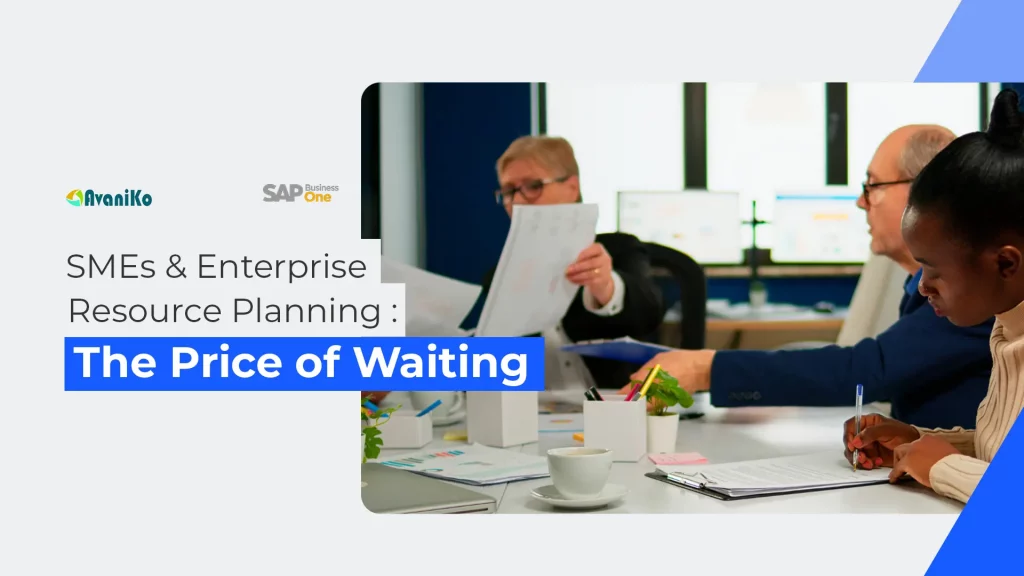SMEs & Enterprise Resource Planning : The Price of Waiting

Running a business without an ERP is like driving with the hand-brake on your wheels still turn, but you burn extra fuel, move slowly, and risk damaging the engine. Studies show SMEs can lose as much as ₹2.1 lakh every month they postpone an ERP project, while their operating costs quietly creep up 15-20 % through manual work-arounds and data errors. Below is a plain-English look at why “doing nothing” is so expensive, told through everyday scenarios any small or mid-sized firm can recognize.
What “doing nothing” really costs
| Hidden drain | Why it happens | Typical hit |
|---|---|---|
| Duplicate data entry | Teams re-key the same figures in accounting, inventory and CRM | +20 % labour cost |
| Late invoices & cash gaps | Spreadsheets get emailed around, approvals stall | Average DSO rises 10-20 % |
| Stockouts & over-stocks | No real-time inventory picture | 25-30 % higher stock holding |
| Lost deals | Quotes prepared slowly, product availability unclear | 8 % revenue left on the table each year |
| Compliance scramble | Paper trails scattered | Fines & audit fees mount |
Scenario stories you’ll recognize
Scenario A – “Paper-Trail Café”
The set-up: A five-store bakery chain uses Excel to track ingredient orders and sales.
The pinch: Two mis-typed numbers mean 200 kg of flour gets ordered twice. Staff spend Saturday counting stock; some bread is binned.
The bill: Extra overtime plus wasted ingredients totals ₹1.5 lakh that weekend-part of the ₹2.1 Lakh/month average loss businesses rack up by delaying ERP
The fix with ERP: Purchase, inventory and sales modules talk to each other, blocking duplicate POs and warning when usage spikes.
Scenario B – “Glow Lamps Warehouse”
The set-up: A lighting wholesaler holds ₹2 crore in bulbs “just in case”.
The pinch: Financial audit shows inventory carrying costs run 20-25 % higher than peers who use modern ERP systems
The bill: Excess stock ties up working capital they could have spent on marketing new smart-home products.
The fix with ERP: Real-time demand forecasting flags slow movers and automates re-order points, cutting stock by a quarter within six months.
Scenario C – “SwiftSales Online”
The set-up: A fast-growing e-commerce start-up juggles five siloed apps. Reports take days, so decisions wait.
The pinch: Management fear a “big bang” change, but experts note SMBs that implement cloud ERP typically break even in 6-12 months. Every month they delay, they miss savings and extra sales.
The bill: Lost opportunity equals 2-10 % revenue growth they never capture.
Fix with ERP: Start small—finance + inventory module-then plug in CRM later. Cloud subscriptions spread cost and staff learn in bite-sized steps.
Why waiting gets harder (and pricier)
Data migration snowballs – the more ad-hoc spreadsheets you collect, the larger the cleanup will be later.
User habits calcify – staff cling to old shortcuts; change-management effort doubles.
The competitive gap widens – rivals on modern ERP spot trend faster and undercut prices.
ROI clock stalls – every month deferred pushes back a pay-back already proven to be achievable within a year for most cloud ERPs
Simple first steps to break indecision
- Put numbers on the pain
Use a quick worksheet: list manual tasks, hours per week, and error rates. Even conservative math reveals thousands in “invisible” cost.
- Pilot, don’t plunge
Modern ERPs let you start with finance only, then switch on inventory, CRM, or production later. This keeps budgets bite-sized and builds internal champions early.
- Tap vendor funding & SaaS pricing
Cloud providers and local banks often bundle low-interest loans or phased payment plans for SMEs.
- Learn from others’ wins and mistakes
Case studies from Cadbury, Nestle and 150-employee ABC Compounding show measurable savings once ERP is live. Share the stories within yourself to overcome your fear of the unknown.
- Key take-away
Indecision has a price tag-whether it shows up as overtime, excess stock, or missed sales. Every month an SME postpones ERP; cash quietly leaks away, and the eventual change only gets tougher. The cure isn’t a giant, risky leap; it’s a series of small, planned steps that turn today’s hidden costs into tomorrow’s profits. Start measuring, start small, and start now.